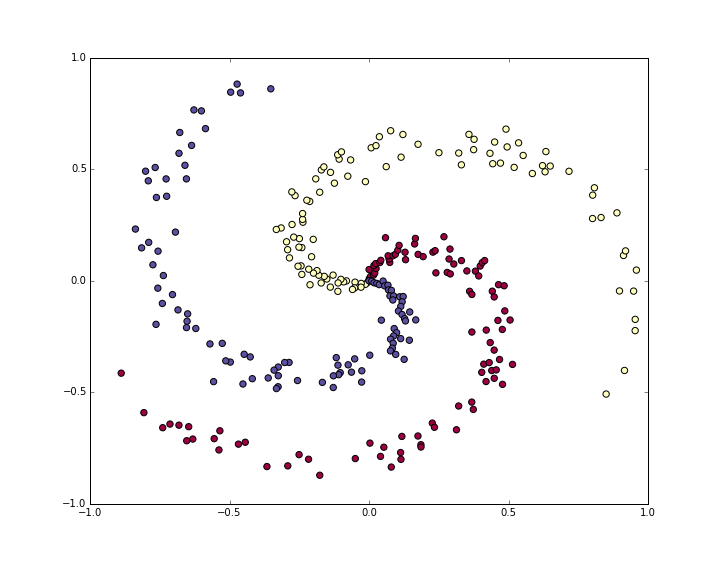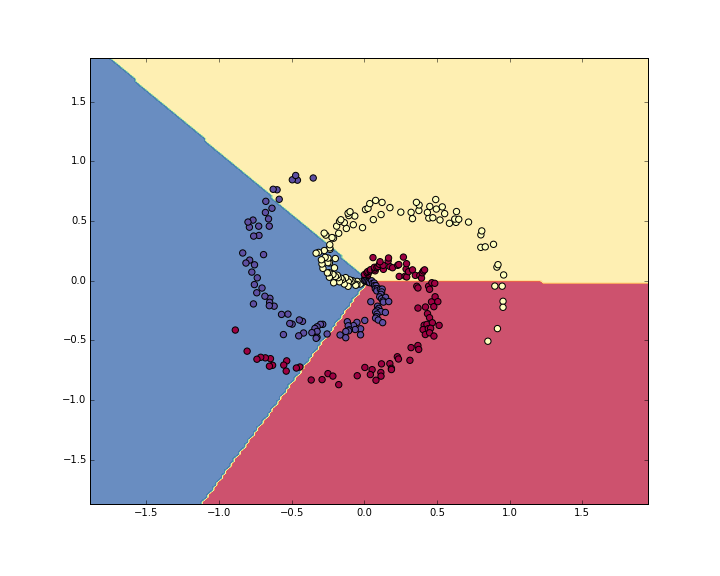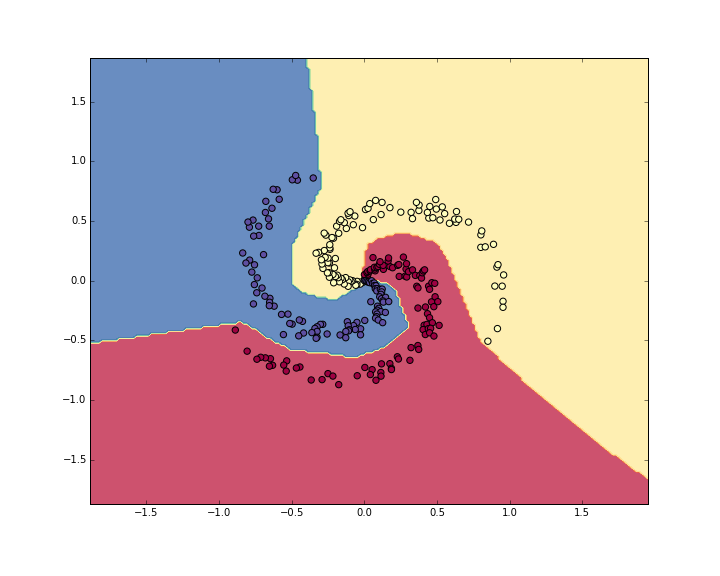Stanford大の教材CS231nを使ってNNやCNNを学んでいる.
この記事では、toy Neural Networkを実装する。
最初にシンプルなlinear classifierを作り、その次に2層NNへ拡張する
Generating some data
- 簡単に線形分離できないdatasetを生成する
- 例として渦状のデータとする
- クラスごとに100点生成
N = 100 # number of points per class D = 2 # dimensionality K = 3 # number of classes X = np.zeros((N*K,D)) # data matrix (each row = single example) y = np.zeros(N*K, dtype='uint8') # class labels for j in xrange(K): ix = range(N*j,N*(j+1)) r = np.linspace(0.0,1,N) # radius t = np.linspace(j*4,(j+1)*4,N) + np.random.randn(N)*0.2 # theta X[ix] = np.c_[r*np.sin(t), r*np.cos(t)] y[ix] = j # lets visualize the data: plt.scatter(X[:, 0], X[:, 1], c=y, s=40, cmap=plt.cm.Spectral)
 (CS231nより引用)
(CS231nより引用)
Training a Softmax Linear Classifier
Initialize the parameters
- パラメータ生成と初期化
python D = 2は次元python K = 3は分類クラスの数
# initialize parameters randomly W = 0.01 * np.random.randn(D,K) b = np.zeros((1,K))
Compute the class scores
- linear classifierを作るので、行列-ベクトル積を計算する
# compute class scores for a linear classifier
scores = np.dot(X, W) + b
- 2次元の300個の点なので、
python scoresは[300 * 3]というサイズ- 各行はそれぞれのクラスの点を保持(blue, red, yellow)
Compute the loss
- loss functionの計算
- クラスごとのscoresがどのくらい満たされてないかを示す
- ここではloss functionにsoftmaxのcross-entropy loss(交差エントロピー損失)を使う
はクラスごとのscore、
$$ L_{i} = - \log \frac{e^{f_{y_{i}}}}{\sum_{j} e^{f_{j}}} $$
logの中身は、真のクラスの正規化された確率を示す
- 真のクラスのscoreが小さければ、lossは無限になる
- 逆に大きければ、0に近づく
完全なSoftmax classifier loss は、cross-entropy lossの平均と、正規化項の和になる
$$ L = \frac{1}{N} \sum_{i} L_{i} + \frac{1}{2} \sum_{k} \sum_{l} W_{k,l}^{2} $$
- scoreをもとにlossを計算する
# get unnormalized probabilities exp_scores = np.exp(scores) # normalize them for each example probs = exp_scores / np.sum(exp_scores, axis=1, keepdims=True)
- クラス分類ごとに正規化する
corect_logprobs = -np.log(probs[range(num_examples),y])
- 完全なlossは上記のlogをとって平均化したものに、正規化 lossを足したもの
# compute the loss: average cross-entropy loss and regularization data_loss = np.sum(corect_logprobs)/num_examples reg_loss = 0.5*reg*np.sum(W*W) loss = data_loss + reg_loss
Computing the Analytic Gradient with Backpropagation
- lossを最小化したい。そのためにgradient descentする
- ランダムなパラメータから始め、
- loss functionの勾配を評価し、
- どうパラメータを移動すればよいか判断する
- 中間変数[tex:{p}}を導入する
- 確率を表現
$$ p_{k} = \frac{e^{f_{y_{i}}}}{\sum_{j} e^{f_{j}}} \ \ \ \ \ \ \ \ \ L_{i} = - \log (p_{y_{i}}) $$
- 確率を表現
を求めたい
は
に依存しており、
は
に依存している
- 連鎖律を使って求めていく
$$ \frac{\partial L_{i}}{\partial f_{k}} = p_{k} - 1(y_{i} = k) $$
- スコアの勾配
python dscoresを得る
dscores = probs dscores[range(num_examples),y] -= 1 dscores /= num_examples
- スコアの勾配から重み
と
の勾配を算出していく
dW = np.dot(X.T, dscores) db = np.sum(dscores, axis=0, keepdims=True) dW += reg*W # don't forget the regularization gradient
Performing a parameter update
- 勾配が減る方向に動かす
# perform a parameter update
W += -step_size * dW
b += -step_size * db
Putting it all together: Training a Softmax Classifier
- 全てを一つにまとめる。
これがsoftmax classifierの全体
#Train a Linear Classifier # initialize parameters randomly W = 0.01 * np.random.randn(D,K) b = np.zeros((1,K)) # some hyperparameters step_size = 1e-0 reg = 1e-3 # regularization strength # gradient descent loop num_examples = X.shape[0] for i in xrange(200): # evaluate class scores, [N x K] scores = np.dot(X, W) + b # compute the class probabilities exp_scores = np.exp(scores) probs = exp_scores / np.sum(exp_scores, axis=1, keepdims=True) # [N x K] # compute the loss: average cross-entropy loss and regularization corect_logprobs = -np.log(probs[range(num_examples),y]) data_loss = np.sum(corect_logprobs)/num_examples reg_loss = 0.5*reg*np.sum(W*W) loss = data_loss + reg_loss if i % 10 == 0: print "iteration %d: loss %f" % (i, loss) # compute the gradient on scores dscores = probs dscores[range(num_examples),y] -= 1 dscores /= num_examples # backpropate the gradient to the parameters (W,b) dW = np.dot(X.T, dscores) db = np.sum(dscores, axis=0, keepdims=True) dW += reg*W # regularization gradient # perform a parameter update W += -step_size * dW b += -step_size * db
- これを実行すると以下の出力を得る
iteration 0: loss 1.096956 iteration 10: loss 0.917265 iteration 20: loss 0.851503 iteration 30: loss 0.822336 iteration 40: loss 0.807586 iteration 50: loss 0.799448 iteration 60: loss 0.794681 iteration 70: loss 0.791764 iteration 80: loss 0.789920 iteration 90: loss 0.788726 iteration 100: loss 0.787938 iteration 110: loss 0.787409 iteration 120: loss 0.787049 iteration 130: loss 0.786803 iteration 140: loss 0.786633 iteration 150: loss 0.786514 iteration 160: loss 0.786431 iteration 170: loss 0.786373 iteration 180: loss 0.786331 iteration 190: loss 0.786302
- 190回の反復で収束する
- このtraining setを評価する
# evaluate training set accuracy scores = np.dot(X, W) + b predicted_class = np.argmax(scores, axis=1) print 'training accuracy: %.2f' % (np.mean(predicted_class == y))
- 49%を得る。 そこまで良くはない。
 (CS231nより引用)
(CS231nより引用)
- 無理やり線形分離している…
Training a Neural Network
- NNで同じ課題に取り組んでみる
- 隠れ層が必要なので、その分重みとバイアスを用意
# initialize parameters randomly h = 100 # size of hidden layer W = 0.01 * np.random.randn(D,h) b = np.zeros((1,h)) W2 = 0.01 * np.random.randn(h,K) b2 = np.zeros((1,K))
- scoreを計算するforward passも2層分
# evaluate class scores with a 2-layer Neural Network hidden_layer = np.maximum(0, np.dot(X, W) + b) # note, ReLU activation scores = np.dot(hidden_layer, W2) + b2
- 2層目のパラメータの勾配を計算
# backpropate the gradient to the parameters # first backprop into parameters W2 and b2 dW2 = np.dot(hidden_layer.T, dscores) db2 = np.sum(dscores, axis=0, keepdims=True)
- 1層目のパラメータの勾配を計算するために、逆伝播していく
dhidden = np.dot(dscores, W2.T)
- ReLU関数をbackprop
# backprop the ReLU non-linearity dhidden[hidden_layer <= 0] = 0
- 1層目のパラメータの勾配を計算
# finally into W,b dW = np.dot(X.T, dhidden) db = np.sum(dhidden, axis=0, keepdims=True)
- パラメータの更新は変更なし
- 以下が完全なコード
# initialize parameters randomly h = 100 # size of hidden layer W = 0.01 * np.random.randn(D,h) b = np.zeros((1,h)) W2 = 0.01 * np.random.randn(h,K) b2 = np.zeros((1,K)) # some hyperparameters step_size = 1e-0 reg = 1e-3 # regularization strength # gradient descent loop num_examples = X.shape[0] for i in xrange(10000): # evaluate class scores, [N x K] hidden_layer = np.maximum(0, np.dot(X, W) + b) # note, ReLU activation scores = np.dot(hidden_layer, W2) + b2 # compute the class probabilities exp_scores = np.exp(scores) probs = exp_scores / np.sum(exp_scores, axis=1, keepdims=True) # [N x K] # compute the loss: average cross-entropy loss and regularization corect_logprobs = -np.log(probs[range(num_examples),y]) data_loss = np.sum(corect_logprobs)/num_examples reg_loss = 0.5*reg*np.sum(W*W) + 0.5*reg*np.sum(W2*W2) loss = data_loss + reg_loss if i % 1000 == 0: print "iteration %d: loss %f" % (i, loss) # compute the gradient on scores dscores = probs dscores[range(num_examples),y] -= 1 dscores /= num_examples # backpropate the gradient to the parameters # first backprop into parameters W2 and b2 dW2 = np.dot(hidden_layer.T, dscores) db2 = np.sum(dscores, axis=0, keepdims=True) # next backprop into hidden layer dhidden = np.dot(dscores, W2.T) # backprop the ReLU non-linearity dhidden[hidden_layer <= 0] = 0 # finally into W,b dW = np.dot(X.T, dhidden) db = np.sum(dhidden, axis=0, keepdims=True) # add regularization gradient contribution dW2 += reg * W2 dW += reg * W # perform a parameter update W += -step_size * dW b += -step_size * db W2 += -step_size * dW2 b2 += -step_size * db2
- これを実行すると以下の出力を得る
iteration 0: loss 1.098744 iteration 1000: loss 0.294946 iteration 2000: loss 0.259301 iteration 3000: loss 0.248310 iteration 4000: loss 0.246170 iteration 5000: loss 0.245649 iteration 6000: loss 0.245491 iteration 7000: loss 0.245400 iteration 8000: loss 0.245335 iteration 9000: loss 0.245292
- training accuercyは98%
# evaluate training set accuracy hidden_layer = np.maximum(0, np.dot(X, W) + b) scores = np.dot(hidden_layer, W2) + b2 predicted_class = np.argmax(scores, axis=1) print 'training accuracy: %.2f' % (np.mean(predicted_class == y))
 (CS231nより引用)
(CS231nより引用)
Summary
- toy 2Dデータセットを使って、linear networkと2層NNをtraining
- コード的には、小さな差しかない
- score function
- backpropagation
- 結果をみると歴然たる違いがあった